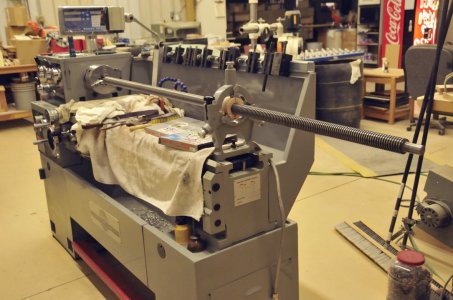-
Welcome back Guest! Did you know you can mentor other members here at H-M? If not, please check out our Relaunch of Hobby Machinist Mentoring Program!
You are using an out of date browser. It may not display this or other websites correctly.
You should upgrade or use an alternative browser.
You should upgrade or use an alternative browser.
Long work
- Thread starter Larry42
- Start date
- Joined
- Nov 25, 2015
- Messages
- 8,301
what's a case clamp?
why maple and not AL or other metal? Did the maple run well in the steady?
why maple and not AL or other metal? Did the maple run well in the steady?
It ran fine. Maple is a good bearing material and this is located in a woodworking plant! When maple is soaked in oil the oil wicks to the surface and provides continuous lubrication. I suspect that aluminum running on the threaded surface would quickly be wiped clean of lube.Did the maple run well in the steady?
Wood is a traditional bearing. The aircraft carrier I was on had wood for the bearings to support the 36" diameter propeller shafts outside of the hull. (70,000 shaft HP, 25' 5 blade props!) using sea water as the lube/cooling medium, lasts for years.
In building wooden casework (boxes/cabinets) they need to be clamped quickly, uniformly and square. Our case clamp does that by having alternating beams that pass through each other so the force is applied in both directions at the same time. The beam sets are powered by electric motors that are controlled by a PLC. As the beams approach the case, laser sensors detect the case and slow the motors so they both reach the case at the same time. When the programed pressure is reached the motors shut off and hold the work until the timer releases and backs the beams away allowing the case to be pushed on through and the next one pushed in. We use a cycle time of 3 minutes. Dowel construction.what's a case clamp?
- Joined
- Nov 25, 2015
- Messages
- 8,301
once you told me where it was, I kinda figured that out. I didn't know this was a ww plant. I had no idea about the aircraft carriers using wooden bearings. pretty cool. I thought they ran in bronze bearings and packing. I guess that's naïve.In building wooden casework (boxes/cabinets) they need to be clamped quickly, uniformly and square. Our case clamp does that by having alternating beams that pass through each other so the force is applied in both directions at the same time. The beam sets are powered by electric motors that are controlled by a PLC. As the beams approach the case, laser sensors detect the case and slow the motors so they both reach the case at the same time. When the programed pressure is reached the motors shut off and hold the work until the timer releases and backs the beams away allowing the case to be pushed on through and the next one pushed in. We use a cycle time of 3 minutes. Dowel construction.
- Joined
- Mar 26, 2014
- Messages
- 1,495
Hi Larry
Do you use pre-glued dowels? Or do you use a glue applicator? How do you put the backs on? Plant on back? Dado with a nailer strip? We use blind dados for our cabinet construction. I have been looking at case clamps, but wasn't sure if it would be any faster.
Nice job by the way! Hope you are staying busy. We are certainly busy here.
Thanks
Cheers
Martin
Do you use pre-glued dowels? Or do you use a glue applicator? How do you put the backs on? Plant on back? Dado with a nailer strip? We use blind dados for our cabinet construction. I have been looking at case clamps, but wasn't sure if it would be any faster.
Nice job by the way! Hope you are staying busy. We are certainly busy here.
Thanks
Cheers
Martin
- Joined
- Jul 31, 2020
- Messages
- 765
Yes, Lignum Vitae was used as shaft bearings. Also Olneya tesota, Arizona Ironwood was used as well. World War II essentially denuded the state of all examples of that species of tree which were of any reasonable size. Although Lignum Vitae was denser, Ironwood had the advantage of being domestically sourced during a time of war. Both woods are so dense, that they sink when placed in water.I think the wood used on the carrier bearings was lignum vitae.
- Joined
- Apr 14, 2014
- Messages
- 3,152
It's interesting that you and I used an almost identical solution to a similar problem. A friend of mine is refurbishing an old farm windmill. He needed a 1" shaft 4' long polished and a couple bearings fit on it. The working envelope of my Sheldon lathe is only 36" so I used the same method to hold the shaft. Yours is slightly more elegant in that I only used Honda assembly lube on the steady rest fingers to keep things running smooth.


